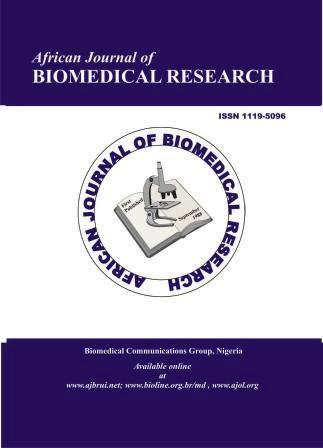Some Health Effects of Exposure to Static Magnetic Fields and Radiofrequency Energy among MRI Staff Working with 1.5 and 3.0 Tesla Scanners In South Africa
DOI:
https://doi.org/10.4314/Keywords:
Health effects, MRI scanners, exposure assessment, questionnaires, 1.5 and 3 T scannersAbstract
Occupational exposure to magnetic resonance imaging (MRI)-related electromagnetic fields is associated with the development
of adverse and transient health effects. The aim of this study was to assess the health effects associated with exposure to Static
Magnetic Fields (SMFs) and radiofrequency (RF) energy amongst MRI staff in 1.5 and 3.0 T MRI units. Data were collected
through questionnaires completed by 42 MRI staff members working in Hospital A (57.89%) and Hospital B (42.11%) in the
Mangaung metropolitan region. Of the participating staff, four did not indicate the facilities in which they worked. Twenty-four
of the participants were female and eighteen were male, and their mean age was 37 years (range of 20 to 61). The questionnaire
was categorized in terms of the participants’ biographical, work, and health-related information. Radiographers (35.71%), student
radiographers (11.9%), nurses (9.52%), medical physicists (4.76%), maintenance engineers (4.76%), radiologists (9.52%), and
cleaners (23.81%) working in both hospitals participated in the study. The data was analysed to determine the percentages and
frequencies for the categorical data. Of the 42 participants, 30.95% reported hypertension, 11.9% reported hypotension, 2.38%
reported cataracts, 16.67% reported depression, and 16.67% reported increased heart rates as a priori-unrelated health effects.
Regarding priori-related health effects, 26.19% of the participants reported a metallic taste, 40.48% reported vertigo, 21.43%
reported nausea, 7.14% reported hypothermia, 2.38% reported hyperthermia, 19.05% reported concentration difficulties, 21.43%
reported blurred vision, and 19.05% reported vitamin deficiencies. Vertigo was reported to be the most common SMF exposurerelated effect. Of the 61.9% of MRI staff who wore PPE, 30.77% were found to wear MRI-related PPE when working in the
MRI units. The results reported in this study were found to be consistent with the exposure-related effects of MRI units
investigated in many other studies. The results also suggest future studies that could determine the association between exposure
and the development of depression and cataracts in a larger study population of MRI workers.










